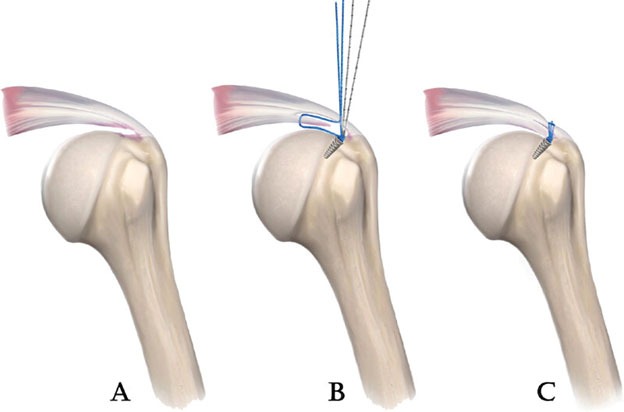- October 22, 2019

Bursal-Sided Rotator Cuff Tears
The subacromial bursa is a fluid-filled sac that assists in reducing friction between the acromion bone of the shoulder blade and the rotator cuff. A bursal-sided rotator cuff tear is a type of injury affecting the rotator cuff, mainly on the side next to the subacromial bursa. A bursal-sided rotator cuff tear happens on the exterior surface of the rotator cuff tendons that face the bursa. This is not the same as the articular side tears, which happen on the inner surface of the joint capsule. Bursal-sided rotator cuff tears are often caused by subacromial impingement syndrome, where repetitive overhead ...

Pasta Transtendon Repair
Pasta transtendon repair is a kind of surgical repair employed for addressing fractional thickness of rotator cuff tear, specifically when the tendon's articular side is involved. The full form of the term PASTA is Partial Articular Supraspinatus Tendon Avulsion," which highlights the particular position and kind of injuries. These tears are very common and occur because of overuse, degenerative alterations, and trauma in your shoulder. Pasta transtendon repair helps in preserving the bursal side of the tendon completely and efficiently repairs the injured part. The rotator cuff is a group of four different muscles and associated tendons that helps in ...

Brachial Plexus Injury in Newborns
The brachial plexus is a network of nerves present around the shoulder. These nerves offer a sense of feeling and muscular control in the hand, fingers, shoulder, arm, and forearm. When these nerves suffer injury, it causes loss of motion or weakness, which is called brachial plexus injury. There are many types of brachial plexus injuries based on the location of the nerve damage. Some of the common causes that lead to brachial plexus injury in newborns are: Complicated birth, such as breech delivery. Mothers suffering long labor. Baby's weight is more than 8 pounds. The shoulder of the baby ...

Shoulder Cartilage Injuries and Arthritis
The two major bones that make up your shoulder joint are the humerus and the scapula. The point where these bones meet, known as the glenohumeral joint, is covered by cartilage. This helps in the smooth movement of the joint with minimum friction. When this cartilage suffers injuries, movement of the joint becomes painful, limited, and not smooth. Cartilage injuries in the shoulder vary based on factors such as location and how severe it is. They vary from very small-sized injuries to full loss of cartilage on both sides. When the injury is restricted to only a small area, it ...

Complications of soft tissue injuries of the shoulder
Soft tissues mainly refer to muscles, tendons, and ligaments that surround and support the joints. The soft tissue within your shoulder helps in maintaining regular movement and functioning. Soft tissue injuries of the shoulder occur because of a fall with an outstretched hand, direct blow, or overuse. Some soft tissue injuries include bruises, strains, sprains, etc. Bruises occur when blood vessels are damaged, leading to skin color changes and swelling. Sprains occur when ligaments responsible for joining bones are damaged and strains are caused by the tearing of muscle fibers. Cause of soft tissue injury of the shoulder The reasons ...

Little League Shoulder
Little league shoulder is a kind of injury of the humerus at a place called growth plate where the bone is still developing. This kind of injury occurs because of stress or overuse where it widens the growth plate, causing swelling and pain in the shoulder. Little league shoulder is very common among young athletes, aged 11 to 16. With proper treatment, the condition gets better, but if left untreated, it can worsen and cause damage to the bone. Some of the factors responsible for this injury are: Recurring throwing without required rest Throwing with unsuitable mechanics Less strength in ...


